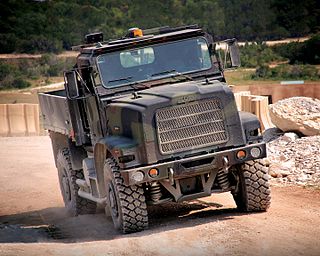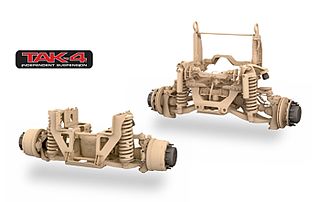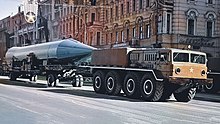
The Heavy Expanded Mobility Tactical Truck (HEMTT) is an eight-wheel drive, diesel-powered, 10-short-ton (9,100 kg) tactical truck. The M977 HEMTT first entered service in 1982 with the United States Army as a replacement for the M520 Goer, and since that date has remained in production for the U.S. Army and other nations. By Q2 2021, around 35,800 HEMTTs in various configurations had been produced by Oshkosh Defense through new-build contracts and around 14,000 of these had been re-manufactured. Current variants have the A4 suffix.

Oshkosh Corporation, formerly Oshkosh Truck, is an American industrial company that designs and builds specialty trucks, military vehicles, truck bodies, airport fire apparatus, and access equipment. The corporation also owns Pierce Manufacturing, a fire apparatus manufacturer in Appleton, Wisconsin, and JLG Industries, a manufacturer of lift equipment, including aerial lifts, boom lifts, scissor lifts, telehandlers and low-level access lifts.

The Medium Tactical Vehicle Replacement (MTVR) is a series of vehicles used by the U.S. Marines. The first MTVRs were delivered in late 1999. The MTVR is the equivalent of the U.S. Army's Family of Medium Tactical Vehicles (FMTV); the Marines do not use the FMTV and the Army does not use the MTVR.

Six-wheel drive is an all-wheel drive drivetrain configuration of three axles with at least two wheels on each axle capable of being driven simultaneously by the vehicle's engine. Unlike four-wheel drive drivetrains, the configuration is largely confined to heavy-duty off-road and military vehicles, such as all-terrain vehicles, armored vehicles, and prime movers.

The Family of Medium Tactical Vehicles (FMTV) is a series of military vehicles that are based on a common chassis and vary by payload and mission requirements. The FMTV is derived from the Austrian Steyr 12M18 truck, but substantially modified to meet United States Army requirements, these including a minimum 50 percent U.S. content.

The Palletized Load System (PLS) is a truck-based logistics system that entered service in the United States Army in 1993. It performs long and short distance freight transport, unit resupply, and other missions in the tactical environment to support modernized and highly mobile combat units. It provides rapid movement of combat configured loads of ammunition and all classes of supply, shelters and intermodal containers. It is similar to systems such as the British Demountable Rack Offload and Pickup System (DROPS).

The M939 is a 5-ton 6×6 U.S. military heavy truck. The basic cargo versions were designed to transport a 10,000 pounds (4,500 kg) cargo load over all terrain in all weather. Designed in the late 1970s to replace the M39 and M809 series of trucks, it has been in service ever since. The M939 evolved into its own family of cargo trucks, dump trucks, semi-tractors, vans, wreckers, and bare chassis/cabs for specialty bodies. 44,590 in all were produced.

TerraMax is the trademark for autonomous/unmanned ground vehicle technology developed by Oshkosh Defense. Primary military uses for the technology are seen as reconnaissance missions and freight transport in high-risk areas so freeing soldiers from possible attacks, ambushes or the threat of mines and IEDs. The technology could also be used in civilian settings, such as autonomous snow clearing at airports.

The Logistics Vehicle System (LVS), nicknamed by U.S. Marines as "Dragon Wagon", is a modular assortment of eight-wheel drive all-terrain vehicle unit combinations used by the United States Marine Corps.
Plasan is an Israeli-based company that now specializes in survivability solutions for all domains, the design, development and manufacture of protected vehicles, and most recently maneuvering robotics.

The M1120 HEMTT LHS is a M977 Heavy Expanded Mobility Tactical Truck with a load handling system in place of a flat bed/cargo body. The HEMTT is an eight-wheel drive, diesel-powered, tactical truck used by the US military and others. The HEMTT is manufactured by Oshkosh Defense and entered Army service in 1982, with the M1120 variant first produced in 1999.

The Future Tactical Truck System (FTTS) was a United States Armed Forces program for which the Operational Requirements Document was drawn up during 2003. FTTS was a proposed two vehicle modular family that was to replace the AM General High Mobility Multipurpose Wheeled Vehicle, Family of Medium Tactical Vehicles (FMTV), Oshkosh M977 Heavy Expanded Mobility Tactical Truck (HEMTT), Palletized Load System (PLS), and all remaining M35, M809 and M939 series of 2.5 and 5 ton trucks. The FTTS-UV was to replace the HMMWV, while the FTTS-MSV was to replace all other types.

The LX and FX are ranges of purpose-designed tactical military trucks manufactured by what is now Rheinmetall MAN Military Vehicles (RMMV). They were replaced in production by the HX range. There was also an MX range, but this was only produced in very small numbers for the German Navy.

The 2+1⁄2-ton, 6×6 truck was a standard class of medium duty trucks, designed at the beginning of World War II for the US Armed Forces, in service for over half a century, from 1940 into the 1990s. Also frequently known as the deuce and a half, or just deuce, this nickname was popularized post WWII, most likely in the Vietnam war era. The basic cargo versions were designed to transport a cargo load of nominally 2+1⁄2 short tons over all terrain, in all weather. The 2+1⁄2-ton trucks were used ubiquitously in World War II, and continued to be the U.S. standard medium duty truck class after the war, including wide usage in the Korean and Vietnam Wars, as well as the first Gulf War.

The Logistic Vehicle System Replacement (LVSR) is a family of heavy-duty military logistics vehicles of the United States Marine Corps (USMC) based on a common 5-axle ten-wheel drive (10x10) chassis. The vehicles vary in individual configuration by mission requirements, with three variants in service: a cargo, a wrecker and a tractor truck. The LVSR was designed and is manufactured by Oshkosh Defense.

TAK-4 independent suspension system is a family of independent suspension systems designed and manufactured by Oshkosh Corporation for use on military, severe-duty and emergency vehicles. The system was developed from the mid-1990s.






























